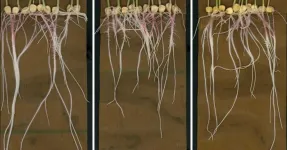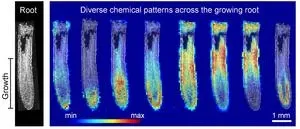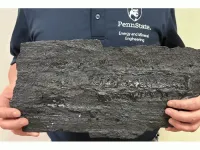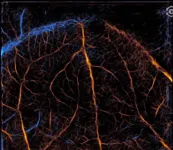(Press-News.org) On a sunny springtime stroll through a park, it’s easy to ignore the parts of plants that are hidden from view. Plant biologists see things differently. They look below the surface where plant roots are organized in elaborate systems that are critical to the organism’s development. Intricately organized tree root systems, for example, can span as far underground as the tree grows high above the soil.
Applying an advanced imaging technology to plant roots, researchers at the University of California San Diego and Stanford University have developed a new understanding of essential root chemicals that are responsible for plant growth. Using a type of mass spectrometer, a study led by UC San Diego Biological Sciences Postdoctoral Scholar Tao Zhang and Assistant Professor Alexandra Dickinson produced a “roadmap” that profiles where key small molecules are distributed along stem cells of maize (corn) plant roots and how their placement factors into the plant’s maturation. The findings were published in the journal Nature Communications.
“This chemical roadmap provides a resource that scientists can use to find new ways of regulating plant growth,” said Dickinson, a faculty member in the Department of Cell and Developmental Biology. “Having more information about how roots grow could be useful in conservation as we think about protecting our plants in natural environments and making them more sustainable, especially in agriculture.”
While working as a visiting scientist at Stanford University, Dickinson began collaborating with study co-first author Sarah Noll and Professor Richard Zare, who developed a mass spectrometry imaging system that helps surgeons distinguish between cancerous and benign tissue during tumor-removal operations.
Dickinson, Zare and Noll adapted the technology—called “desorption electrospray ionization mass spectrometry imaging” or DESI-MSI—to probe plant roots for the chemicals involved in growth and energy production. They initially focused on maize plants at the root tips, where stem cells play an active role in the plant’s development. Their method involved cutting through the center of the root to get a clear image of the chemicals inside.
“To help understand plant roots from the biology side, we needed to find out which chemicals are there,” said Zare. “Our imaging system sprays out droplets that strike different portions of the root and dissolve chemicals at that location. A mass spectrometer collects the droplet splash and tells us what those dissolved chemicals are. By systematically scanning the droplet target spot we make a spatial map of the root chemicals.”
The resulting images, believed to be some of the first to reveal the transition between stem cells and mature root tissue, show the foundational role of metabolites—molecules involved in the plant’s energy production. Tricarboxylic acid (TCA) cycle metabolites became the focus of the research since they were found to be a key player in controlling root development.
Coming into the study, the researchers expected a relatively uniform distribution of chemicals. Instead, with their chemical roadmap in hand, they found that TCA metabolites are clustered in patches across the root.
“I was surprised by how many chemicals are featured in really distinct patterns,” said Dickinson. “We can see that the plant is doing this on purpose—it needs these molecules in specific regions to grow properly.” The Dickinson lab showed that these TCA metabolites have predictable effects in development, not only in maize, but in another plant species as well (Arabidopsis). This is likely because TCA metabolites are highly conserved—they are made in all plants as well as animals.
Also emerging from the new images were previously unidentified chemical compounds. Dickinson says the mystery compounds could be critical for plant growth since they also are grouped in patterns at specific locations, suggesting a prominent role in development. Dickinson and her colleagues are now investigating these compounds and comparing varieties of maize that have different levels of stress resistance for adverse threats such as severe climate conditions and drought. The new information will help them develop novel chemical and genetic strategies for improving plant growth and stress resilience.
“We’re looking at different maize plants that have drought resistance to see if we’ve already found chemicals that are specific to that variety that we haven’t seen in other varieties,” said Dickinson. “We think that could be a way to find new compounds that can promote growth, especially in harsh conditions.”
The study’s full author list includes: Tao Zhang, Sarah Noll, Jesus Peng, Amman Klair, Abigail Tripka, Nathan Stutzman, Casey Cheng, Richard Zare and Alexandra Dickinson.
END
Groundbreaking images of root chemicals offer new insights on plant growth
Technology used in cancer research leads to roadmap of chemicals important for agriculture, food production and climate resilience
2023-05-25
ELSE PRESS RELEASES FROM THIS DATE:
LJI-led team wins top Nucleate honors for virus vaccine development proposal
2023-05-25
LA JOLLA, CA—A San Diego team, led by scientists at La Jolla Institute for Immunology (LJI), has won the top prizes in the Nucleate Activator competition. Out of 1,000 initial competitors, the LJI team advanced to the final four teams and swept all the prizes they entered for. Their winning research proposal outlines how scientists could stop dengue virus and Zika virus by developing sophisticated vaccines that activate both B cells and T cells.
Nucleate is a student-led, non-profit organization dedicated to empowering early-stage, ...
Hydrogen battery: Storing hydrogen in coal may help power clean energy economy
2023-05-25
UNIVERSITY PARK, Pa. — The quest to develop hydrogen as a clean energy source that could curb our dependence on fossil fuels may lead to an unexpected place — coal. A team of Penn State scientists found that coal may represent a potential way to store hydrogen gas, much like batteries store energy for future use, addressing a major hurdle in developing a clean energy supply chain.
“We found that coal can be this geological hydrogen battery,” said Shimin Liu, associate professor of energy and mineral engineering at Penn State. “You could inject and store the hydrogen energy and have it there when you need to use it.”
Hydrogen ...
Artificial muscle fibers could serve as cell scaffolds
2023-05-25
In two new studies, North Carolina State University researchers designed and tested a series of textile fibers that can change shape and generate force like a muscle. In the first study, the researchers focused on the materials’ influence on artificial muscles’ strength and contraction length. The findings could help researchers tailor the fibers for different applications.
In the second, proof-of-concept study, the researchers tested their fibers as scaffolds for live cells. Their findings suggest the fibers – known as “fiber robots” ...
Argonne hosts demo day for Lab-Embedded Entrepreneurship Program
2023-05-25
Twenty startups will present their technologies for a clean energy future at this year’s Lab-Embedded Entrepreneur Program (LEEP) Demo Day, June 7, in Chicago. LEEP connects entrepreneurs with resources and innovation ecosystems at U.S. Department of Energy (DOE) national labs.
In addition to demos from companies currently participating in LEEP, the event at the Sheraton Grand Chicago Riverwalk will also feature a panel discussion where program graduates share insights and advice about successful entrepreneurship. The technologies on display span renewable energy, materials for clean energy and water, batteries, ...
Helping virtual reality reflect social realities
2023-05-25
Research on virtual reality is expanding as the technology grows, but too much of that research is being conducted with participants who don’t reflect the general population.
The Virtual Experience Research Accelerator (VERA), a $5 million National Science Foundation-funded project, is creating a system to provide researchers with access to large, reliable, diverse groups of participants for an array of research projects on and using VR.
“A lot of research in this area suffers from using participant samples ...
New method tracking changes in blood vessels could advance brain disease detection
2023-05-25
PROVIDENCE, R.I. [Brown University] — While age-related brain disorders like Alzheimer’s disease often develop slowly across an individual’s lifetime, they usually aren’t detected until symptoms have already started. With that in mind, teams of biomedical researchers led by Brown University scientists have been exploring for years whether devastating neurodegenerative diseases could be caught decades earlier — perhaps through something as simple as a routine eye exam instead of a battery of diagnostic tests.
In a new study, one of the Brown-led ...
New framework for super-resolution ultrasound
2023-05-25
Researchers at the Beckman Institute for Advanced Science and Technology used deep learning to develop a new framework for super-resolution ultrasound.
Traditional super-resolution ultrasound techniques use microbubbles: tiny spheres of gas encased in a protein or lipid shell. Microbubbles are considered to be a contrast agent, which means they can be injected into a blood vessel to increase the clarity of an ultrasound image.
Conventional ultrasound has been commonplace for over 50 years. The development of super-resolution technology in the last decade has introduced new challenges. Super-resolution ultrasound provides a much clearer picture than the traditional method. ...
Simon Fraser University becomes global instructor training facility for Siemens mechatronic systems certification program
2023-05-25
Responding to a growing need for training in automation systems in Canada and globally, Siemens and Simon Fraser University (SFU) have announced that SFU is the first and only training facility for instructors delivering the globally recognized Level 3 Siemens Mechatronic Systems Certification program (SMSCP). Instructors, upon completion of the two-week long training will be qualified to deliver the Level 3 certification mechatronics training, vital for providing students with real-world technical skills, and helping prepare them to thrive in a high-tech world of work. Level 1 and Level 2 ...
Reconstructing brain connectivity using 3D images
2023-05-25
Dr. Shuiwang Ji, a professor in the Department of Computer Science and Engineering at Texas A&M University, is part of a collaborative research community that recently had its paper titled “BigNeuron: a resource to benchmark and predict performance of algorithms for automated tracing of neurons in light microscopy datasets” published in the April issue of the journal Nature Methods.
Initiated in 2015 and led by the Allen Institute for Brain Science, BigNeuron is an international initiative that brings together computer scientists and neuroscientists from a dozen institutions. ...
Words matter: How researchers can avoid stigmatizing language
2023-05-25
Word choice matters—a lot— when it comes to research. That’s the main takeaway from a new article co-authored by Edson College of Nursing and Health Innovation Assistant Professor Angel Algarin and published in Health Communication.
“Researchers in any field should be cognizant of the language they’re using to describe the people they study so they don’t inadvertently add to the use of stigmatizing language,” said Algarin.
For the article, Algarin and his co-authors performed a content ...
LAST 30 PRESS RELEASES:
Longest observation of an active solar region
Why nail-biting, procrastination and other self-sabotaging behaviors are rooted in survival instincts
Regional variations in mechanical properties of porcine leptomeninges
Artificial empathy in therapy and healthcare: advancements in interpersonal interaction technologies
Why some brains switch gears more efficiently than others
UVA’s Jundong Li wins ICDM’S 2025 Tao Li Award for data mining, machine learning
UVA’s low-power, high-performance computer power player Mircea Stan earns National Academy of Inventors fellowship
Not playing by the rules: USU researcher explores filamentous algae dynamics in rivers
Do our body clocks influence our risk of dementia?
Anthropologists offer new evidence of bipedalism in long-debated fossil discovery
Safer receipt paper from wood
Dosage-sensitive genes suggest no whole-genome duplications in ancestral angiosperm
First ancient human herpesvirus genomes document their deep history with humans
Why Some Bacteria Survive Antibiotics and How to Stop Them - New study reveals that bacteria can survive antibiotic treatment through two fundamentally different “shutdown modes”
UCLA study links scar healing to dangerous placenta condition
CHANGE-seq-BE finds off-target changes in the genome from base editors
The Journal of Nuclear Medicine Ahead-of-Print Tip Sheet: January 2, 2026
Delayed or absent first dose of measles, mumps, and rubella vaccination
Trends in US preterm birth rates by household income and race and ethnicity
Study identifies potential biomarker linked to progression and brain inflammation in multiple sclerosis
Many mothers in Norway do not show up for postnatal check-ups
Researchers want to find out why quick clay is so unstable
Superradiant spins show teamwork at the quantum scale
Cleveland Clinic Research links tumor bacteria to immunotherapy resistance in head and neck cancer
First Editorial of 2026: Resisting AI slop
Joint ground- and space-based observations reveal Saturn-mass rogue planet
Inheritable genetic variant offers protection against blood cancer risk and progression
Pigs settled Pacific islands alongside early human voyagers
A Coral reef’s daily pulse reshapes microbes in surrounding waters
EAST Tokamak experiments exceed plasma density limit, offering new approach to fusion ignition
[Press-News.org] Groundbreaking images of root chemicals offer new insights on plant growthTechnology used in cancer research leads to roadmap of chemicals important for agriculture, food production and climate resilience





